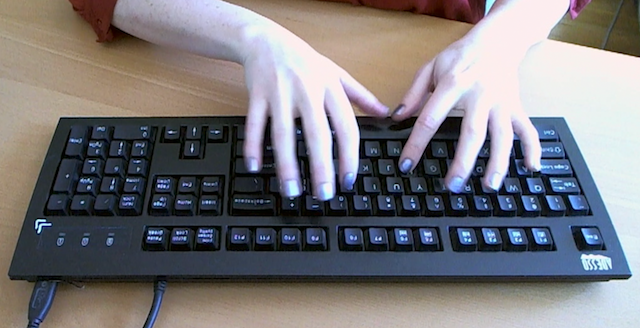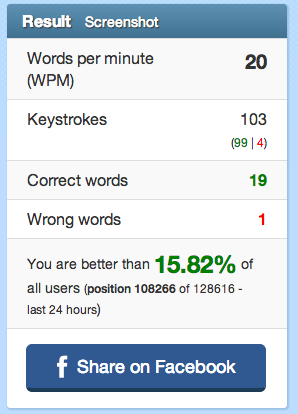
Last week, I embarked on a quest to make my life more difficult—learning the Dvorak keyboard layout for the purposes of comfort and, possibly, even speed gains. The exercise could pay long-term dividends for my job, which at its most basic level, is typing. But initial progress was slow and incredibly painful. It was as if I had to deliberately control every muscle in my leg to take a step, but my job needed me to be Usain Bolt.
That said, I am getting better.
Seven hours in...
After a few days of regular practice, I'm seeing the first signs of progress. Even though I'm not forcing myself to use Dvorak all day, every day, I don't feel any backsliding when I return to it. (However, this may speak more to my wholesale lack of progress than how much muscle memory I'm actually storing.)
The biggest problem with Dvorak is that my thoughts form at the speed of QWERTY typing. In fact, sometimes they're off topic but forming faster. Often, I have to jump out of the Dvorak text I'm working on to another box where I can put away thoughts for digestion later.
To make an analogy as clunky as early Dvorak typing, it's like trying to catch or kill butterflies with a baseball bat. The harder I try, the more success eludes me. There is a zen state I need to be in to achieve any kind of speed. I try to both push through typing and slow the thoughts in my brain down. My drafts do turn out a little shorter and more concise, which probably makes some people happy.
The letter patterns are coming a little easier, so I'm trying to recognize when I come upon one of those. It helps to map out the key presses in my head and then do them in one swift movement. It's not helpful in terms of speed, but it makes the typing feel normal for that split second. "Igh," "tha," "as," "op"/"po," and "id"/"di" are frequently used combos that I can now nail. (I hear you saying "but those are only two, at most three, letters in a row," and to that I say, seriously, you try it.)
Punctuation remains a constant tripping point beyond the comma, period, and apostrophe, which are conveniently located. Question marks, colons, and dashes are productivity killers. So is the letter q, but it comes up less than the aforementioned keys.
Ten hours in…
Even though I take significant time off from Dvorak, my recollection of keys' locations doesn't degrade much. I've built up a very limited muscle memory, and typing still takes a conscious effort.
However, the eureka moments are finally starting to happen. Up until now, if my focus strayed, I would start hitting keys in their QWERTY spots while trying to type in Dvorak. It's quickly gibberish. Recently, a few Dvorak layout reflexes are kicking in when I type in QWERTY. (See the screen shot below for scientific posterity.)

The results of all this struggle? I have finally reached a whopping… 20 words per minute.
Yes, the actual speed gain, according to the typing test, is small (last time I checked in I was at 15 words per minute). But it's not commensurate with how much better I feel about typing. I can get through a whole 200-word piece without wanting to pull the caps from my keyboard, piece by piece, like they are pain-inducing teeth. And I brush off the lack of speed gains by telling myself I type slower when trying to transcribe the text a typing test gives you. Most importantly, the gap between these two benchmarks feels larger when testing my Dvorak skills than my QWERTY ones. My QWERTY typing dropped only a tiny bit in the typing test, down to about 81 wpm. And even then, freeform QWERTY tests peg me at over 100 wpm, so I remain confident.

I still cannot reliably hit the F button in Dvorak. This experiment has convinced me that the entire concept of keyboard layouts as we know them is fundamentally broken when it comes to that button placement. I have more words for where Dvorak places the F, but they're too indelicate for these hallowed pages. Stay tuned for part 3—then I will, somehow, achieve my typing speed goal and make a decision about whether to stick with Dvorak.
A note to our readers: You've given me more good advice than I can process in two lifetimes, and I deeply appreciate it. From the bottom of my heart, thank you. But for the purposes of consistency, I'm sticking by my own methods for the duration of this experiment.
However, you've shared so many thoughtful responses that I will collect and share your input in a separate article as this series winds down. That way, even if I utterly fail, anyone who might give this a try can benefit from your experiences.
reader comments
115